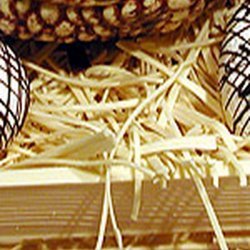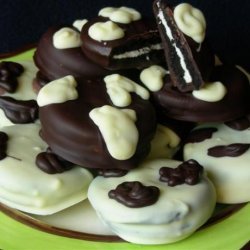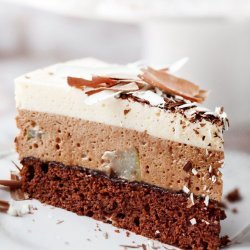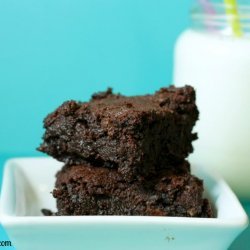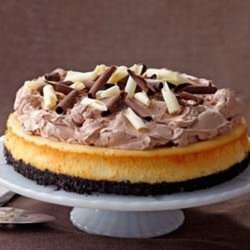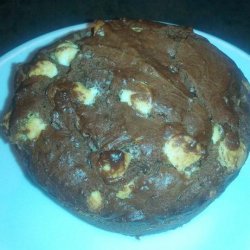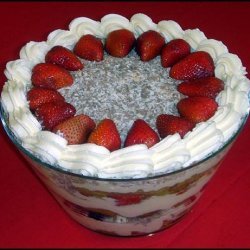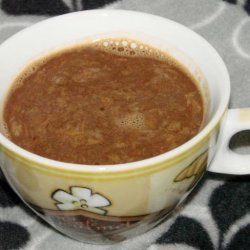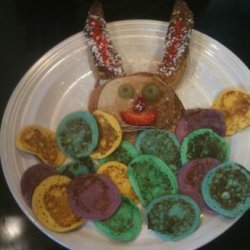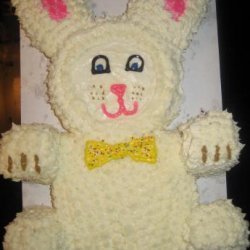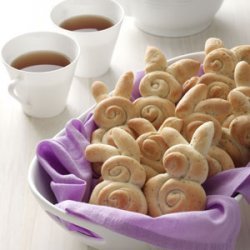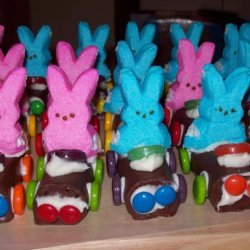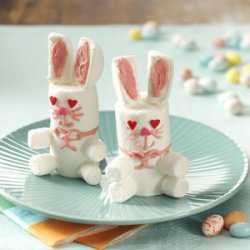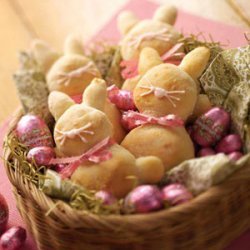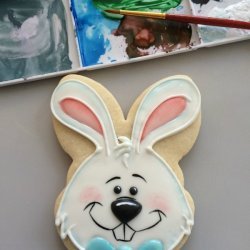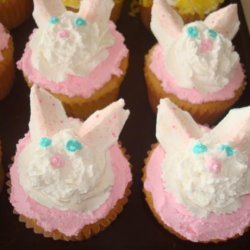Ingredients:
- modeling chocolate (see previous recipe)
- bittersweet chocolate , tempered, 48 oz, 1350 g
- white chocolate, melted , 2 oz, 60 g
- milk chocolate, melted , 2 oz, 60 g
- bittersweet chocolate , tempered, 2 oz, 60 g
Directions:
- You can recreate this centerpiece using any size or shape of molds. I used an egg mold to create the body of the watering can and the bodies of the bunnies. I used 2 of the sizes of the round molds to create the heads and the smallest dome on that mold to make the eyes.
- To make the watering can: It is very easy to mold an egg. Use a ladle to fill the plastic mold with chocolate. When it is full, empty it into the bowl of chocolate. The inside of the egg should be evenly coated with chocolate. Wipe the edge of the plastic mold clean on the side of the bowl or with a knife and place it upside down on a wire rack placed over a baking sheet. Once the chocolate starts to harden, about 5 minutes, scrape the edge clean again with a paring knife. When the chocolate sets, it shrinks or retracts from the sides of the mold. A clean edge will keep it from sticking and cracking as it shrinks. You can place the mold in the refrigerator for several minutes to help the chocolate to harden.
- If the chocolate is properly tempered, it will easily release from the mold. To unmold, gently push down on one side of the molded chocolate and the opposite side will lift from the mold. Use melted chocolate to glue together the two halves. In a professional kitchen, a chef often heats a baking sheet and gently presses each half against the warm metal to melt the edges a little bit. Then we press them together and set aside until the chocolate sets.
- Cut a circle from heavy cardboard that is large enough to serve as a base for your watering can. Use a pastry brush to cover one side with chocolate. Set aside until the chocolate is set. Use this as the base for your watering can. Apply more melted chocolate to the bottom of the egg and glue it to the base. Allow it to set.
- Use a hot serrated knife to cut the top third off of the egg. Be gentle and let the heat of the knife do the work. If you press too hard, the egg will break. If that happens, you may be able to use tempered chocolate to glue it back together. This cut creates the opening to the top of the watering can. You can adjust the size of the opening to accommodate the size of bunnies you are making.
- To make the spout: Roll a piece of acetate paper into a cone shape that is the correct proportion for the size of the body. Fill the cone with tempered chocolate. Set aside until it sets. When it is set, unwrap the acetate. Use a warm serrated knife to cut off the tip until it is an appropriate size for the size of your watering can.
- To make the handle, first draw the shape with a pencil onto a piece of parchment paper. Make one handle then make the mirror image of it. Put some melted chocolate into a bowl. Stir in about 2 teaspoons of water so the chocolate will seize. Place this chocolate in a pastry bag fitted with a 1/2-inch star tip. Use the chocolate to trace over your handles. Set aside until the chocolate sets. When set, use a little melted chocolate to glue together the flat sides of the 2 handles.
- To attach the spout and handle: Use melted chocolate to attach the spout and handle to the watering can. You can prop the spout against something while the chocolate sets. Place the spout on one side and the handle on the opposite side.
- If you want to make the watering can appearance to be rusty or as if it is made of velvet, use the chocolate paint sprayer technique explained in the Easter bonnet recipe. Dont forget to place the watering can in the freezer first.
- Use the same molding technique used for the body of the watering can to make the bodies and heads of the bunnies. I used egg shapes for the bodies and round molds for the heads. You can also use the smallest dome on the round molds to make little cheeks. I made one bunny a little larger than the other. I made additional molds from the smallest dome and cut them in half to create eyelids for the smaller bunny.
- To hide all of the seams on the bunnies, you can use the paint sprayer to spray the bunnies before you attach the eyes, nose and tongue. Do not put the bunny in the refrigerator like you do with the watering can. That way, youll get a different texture.
- To make the ears, nose and tongue: I made the ears by cutting out the ear shapes from parchment paper. Use a pastry brush to paint the tempered chocolate onto the parchment paper. When the chocolate sets, peel off the parchment paper. If you want to bend one ear, do that before the chocolate sets. To attach the ears, use the tip of a paring knife to create a small hole at the top of the head for each ear. It will help if you use a hot knife. Dip the end of the ears in melted chocolate and then slide them gently into the holes you made. Allow them to set.
- You can make the nose and tongue out of modeling chocolate (if you have it from the previous project) or marzipan. Make any shape that strikes your fancy. Adhere the pieces to the face using chocolate to glue them in place.
- To make the eyes, use the smallest circle of the mold (or anything you can find at home). Make three cornets. Fill one with tempered dark chocolate, one with tempered milk chocolate and one with tempered white chocolate. Use the white chocolate to place a small drop in the center of the mold to create the pupil. Use the milk chocolate to make the pupil by piping a slightly larger amount on top of the pupil. Finish with a larger drop of white chocolate directly on top of the other two to create the white of the eye. If youve used a mold with a rounded bottom, the eyes will have a 3-dimensional quality. Affix the eyes by gluing them with a little dark chocolate.
- To make the butterflies: It is easy to reproduce any line drawing in chocolate.
- Place the drawing under a sheet of acetate. The chocolate against the acetate will take on a nice shine. For this reason, I like to make that side the front of the drawing. Make 2 cornets and fill one with tempered dark chocolate and the other with tempered white chocolate. Use the dark chocolate to trace the outline of the drawing onto the acetate. Use both white and dark chocolate to shade the drawing as appropriate. Be sure to completely fill the inside of the drawing so you end up with a solid re-creation of the drawing. It will also be easier to unmold and handle if there are no gaps in the drawing. Place the acetate in the refrigerator to help the drawing to set. To unmold, simply peel the acetate from the front of the chocolate drawing.
- Final assembly: Fill the bottom half of your watering can with crumpled plastic wrap or paper. This will create a seat for the bunnies. Set the bunnies inside the can so they rest on top of the filling. Use a little melted chocolate to attach the butterflies to the watering can. If you want to write Happy Easter on the front of the watering can, do it with melted chocolate that youve placed in a cornet. You can practice on an acetate sheet before you move to the final project. Enjoy!
- Tip: Never coat a mold with fat when you use chocolate. It does not help the chocolate to unmold. Chocolate is like plaster - it retracts when it cools. Chocolate cannot be molded onto any porous surface, like wood or a sponge. In order of preference, the best types of molds are plastic, stainless steel, and glass. Be careful with glass because it retains temperature, whether it is hot or cold. If the glass mold is slightly warm or cold, it will untemper the chocolate before it has time to set. When molding chocolate, always remember that the chocolate takes on the temperature of the mold.
- Sources:
- Team Torres LLC
- PO Box 303
- New York, NY 10101-0303
- 212/489-4847
- 212/489-0142 (fax)
- Mold of domes in 9 sizes ranging from 1/2-inch to 31/2 inches
- Beryls Cake Decorating & Pastry Supplies
- PO Box 1584
- North Springfield, VA 22151
- 800/488-2749
- 703/750-3779 (fax)
- White and dark chocolate, various egg molds, molding chocolate
- Sur La Table
- Catalog Division
- 800/243-0852
- Traditional chocolate bunny molds; egg, lamb and rabbit shaped cake pans; Sinsation Chocolate Tempering Machine; Cutter Sets of assorted shapes and sizes
Nutrition Facts
| Amount Per 1 Serving | |||
| Calories | 4917.6 Kcal (20589 kJ) | ||
| Calories from fat | 1838.7 Kcal | ||
| % Daily Value* | |||
| Total Fat | 204.3g | 314% | |
|---|---|---|---|
| Cholesterol | 257.7mg | 86% | |
| Sodium | 1041mg | 43% | |
| Potassium | 258.6mg | 6% | |
| Total Carbs | 832.8g | 278% | |
| Sugars | 662.4g | 2650% | |
| Dietary Fiber | 28.2g | 113% | |
| Protein | 47.7g | 95% | |
| Vitamin C | 0.6mg | 1% | |
| Iron | 14.1mg | 78% | |
| Calcium | 1131.6mg | 113% | |
| Amount Per 100 g | |||
| Calories | 321.41 Kcal (1346 kJ) | ||
| Calories from fat | 120.18 Kcal | ||
| % Daily Value* | |||
| Total Fat | 13.35g | 314% | |
|---|---|---|---|
| Cholesterol | 16.84mg | 86% | |
| Sodium | 68.04mg | 43% | |
| Potassium | 16.9mg | 6% | |
| Total Carbs | 54.43g | 278% | |
| Sugars | 43.29g | 2650% | |
| Dietary Fiber | 1.84g | 113% | |
| Protein | 3.12g | 95% | |
| Iron | 0.9mg | 78% | |
| Calcium | 74mg | 113% | |
* Percent Daily Values are based on a 2000 calorie diet. Your daily values may be higher or lower depending on your calorie needs.
Find out how many calories should you eat.
Get Your Recipe of Health!
Follow RecipeOfHealth on Facebook!


